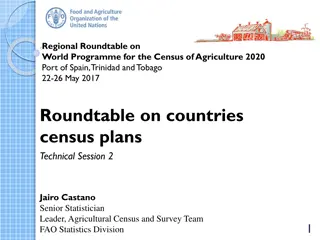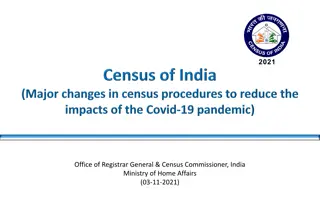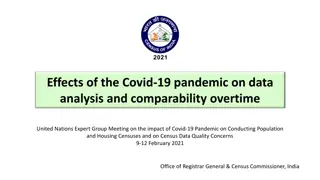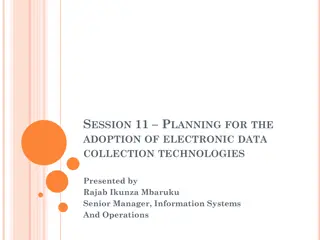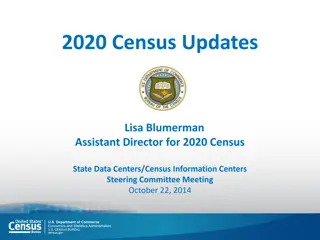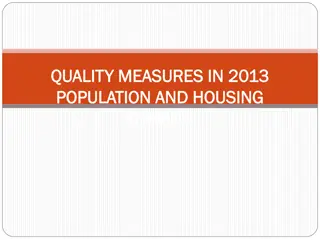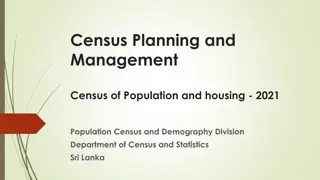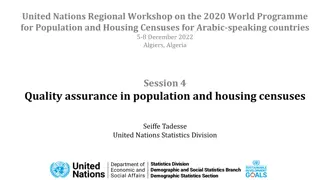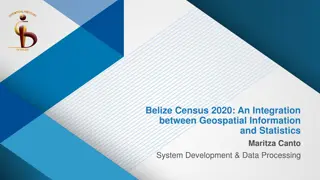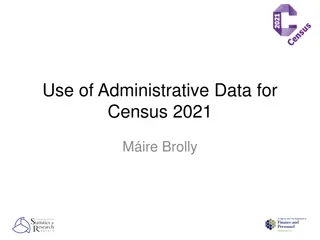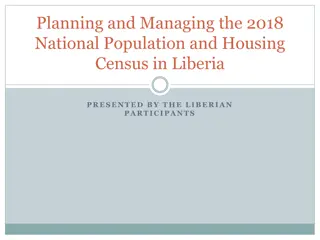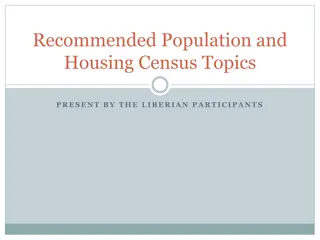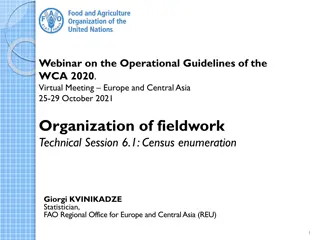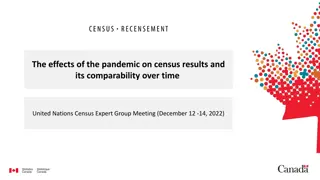
Insights from Croydon Workforce Census 2021
Explore key findings from the Croydon Workforce Census 2021, including workforce demographics, occupational distribution, social class representation, industry breakdown, and hours worked. Understand how Croydon compares to London and England in terms of employment trends and sectors. Gain valuable insights into the local workforce landscape and employment patterns in Croydon.
Uploaded on | 1 Views
Download Presentation

Please find below an Image/Link to download the presentation.
The content on the website is provided AS IS for your information and personal use only. It may not be sold, licensed, or shared on other websites without obtaining consent from the author. If you encounter any issues during the download, it is possible that the publisher has removed the file from their server.
You are allowed to download the files provided on this website for personal or commercial use, subject to the condition that they are used lawfully. All files are the property of their respective owners.
The content on the website is provided AS IS for your information and personal use only. It may not be sold, licensed, or shared on other websites without obtaining consent from the author.
E N D
Presentation Transcript
P Census 2021 & Improvement Service 8. Dec. 2022
Business Intelligence, P Labour Market and Travel to Work Census 2021Service 8. Dec. 2022
Business Intelligence, P DD 8 Dec. 2022
Occupation About 1 in 8 (12.7%) of Croydon s workforce are managers, directors or senior officials. This is slightly lower than in London and England. Nearly 4 in 10 (37.0%) work in professional, Associate professional and technical occupations. One in 10 (10.2%) work in administrative or secretarial occupations which is a slightly higher proportion compared to London and England. One in 10 (9.6%) also work in the caring, leisure and other service industry which is a slightly higher proportion than in London and England. Source: ONS Census 2021 Edmund Fallon, Census 2021
Occupational Social Class (NS-SEC) One in 3 (36%) of Croydon s working residents are in managerial, administrative and professional occupations. Nearly 1 in 5 (18.7%) are doing semi-routine or routine jobs. Nearly 1 in 10 (9.6%) have never worked or have been long-term unemployed. Source: ONS Census 2021 Edmund Fallon, Census 2021
Industry INDUSTRY A: Agriculture, Forestry and fishing B: Mining and quarrying C: Manufacturing D: Electricity, gas, steam and air conditioning supply E: Water supply; Sewerage, Waste management and Remediation activities F: Construction G: Wholesale and retail trade; repair of motor vehicles and motorcycles H: Transport and storage I: Accommodation and food service activities J: Information and communication Croydon London 0.1% 0.1% 2.6% 0.3% 0.3% 8.6% 13.1% 5.3% 4.6% 5.9% England 0.1% 0.1% 3.0% 0.3% 0.3% 7.8% 12.2% 4.7% 5.5% 7.6% 0.8% 0.2% 7.3% 0.6% 0.7% 8.7% 15.0% 5.0% 4.9% 4.7% Croydon has a smaller proportion of workers in the manufacturing industry and accommodation and food services industry compared to both London and England. Croydon has a higher proportion of workers compared to both London and England in the following industries : Transport and storage Financial and insurance Administrative and support services Public administration and support services Human health and social work K: Financial and insurance activities 5.8% 2.0% 7.7% 6.3% 6.9% 9.9% 15.7% 4.9% 100% 6.6% 2.1% 10.5% 6.0% 4.8% 9.6% 12.9% 5.8% 100% 3.8% 1.6% 6.7% 5.3% 5.8% 9.9% 14.6% 4.6% 100% L: Real estate activities M: Professional, scientific and technical activities N: Administrative and support service activities O: Public administration and defence; compulsory social security P: Education Q: Human health and social work activities R, S, T, U Other Total: All usual residents aged 16 years and over in employment the week before the census Source: ONS Census 2021 Edmund Fallon, Census 2021
Individuals Hours Worked 70.6% of the Croydon workforce work full- time for a minimum of 31 hours a week and some of this group work in excess of 49 hours a week. This proportion is similar to the England average (70.2%) but slightly lower than the London average (72.0%). 29.3% of the Croydon workforce were working 30 hours or less a week in part- time jobs around the Census date. Source: ONS Census 2021 Edmund Fallon, Census 2021
Never worked or long-term Unemployed across London (S-SEC) 9.6% of Croydon s working age population have never worked or have been long-term unemployed. Croydon s proportion of this cohort of residents is slightly smaller than the London average of 10.1% Richmond upon Thames has the smallest proportion of never worked or long-term unemployed at 5.5%. Newham has the biggest proportion of never worked or long-term unemployed at 15.1%. Source: ONS Census 2021 Edmund Fallon, Census 2021
Individuals Part-time and Full-time split The proportions of part-time to full-time workers in Croydon, London and England is virtually the same. Wandsworth had 20.3% part- time workers the lowest in London. Enfield has 35.3% pat-time workers the highest in London. Source: ONS Census 2021 Edmund Fallon, Census 2021
Individuals Economic Activity In terms of Economic activity status, Croydon has a similar profile to London. Both in Croydon and in London, the proportion of economically active people is higher than at the national level. Source: ONS Census 2021 Edmund Fallon, Census 2021
Individuals Economically Active across London The proportion of economically active in London ranges from 58.3% in Enfield to 71.5% in Wandsworth. Croydon is virtually the same as the London average (63.5%). Source: ONS Census 2021 Edmund Fallon, Census 2021
Individuals Method of Travel to Work 37.5% of Croydon s were mainly working from home around the time of the Census. 63.3% of its residents are 18-64 years compared to the average for London of 66.6%. 13.6% of its residents are 65 years or over compared to the average for London of 11.9%. Source: ONS Census 2021 Edmund Fallon, Census 2021
Individuals Method of Travel to Work 33.0% more people were working from home in 2021 compared to 10 years ago, no doubt as a result of the new working world in response to the Covid pandemic of 2020. 36.7% of commuters drove a car or van into work in 2011. In 2021, this reduced to 4.3%. There was a higher proportion of passengers in a car or a van in 2021 (27.7%) compared to 2011 (2.3%). A higher percentage of commuters(24.6%) travelled by train in 2011 compared to 2021 (10.5%). Source: ONS Census 2021 Edmund Fallon, Census 2021
Individuals Distance Travelled to Work 37.5% of the working residents of Croydon were working mainly from home on the week before Census Day. This was a higher proportion than in England (31.5%) but lower than in London (42.1%). 30.4% worked less than 10km from their work place. 15.2% worked between 10km and 30 km from the work place. Only 1.6% worked further away than 30km. 15.3% worked offshore, in no fixed place or outside the UK. Source: ONS Census 2021 Edmund Fallon, Census 2021




